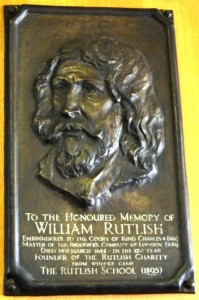 Origins of the Rutlish Foundation
Origins of the Rutlish Foundation
Our original benefactor was William Rutlish (1605-1687), an accomplished and successful ‘broderer’ (brodery was the ancient art of embroidery) who was appointed Court ‘Imbroyderer’ to King Charles II in 1661, and made Master of the Worshipful Company of Broderers in 1686.
Most of the early records of that Company were lost in the Fire of London in 1666, but it certainly dates back to at least 1430.
William Rutlish became a wealthy man and owned considerable property not only in the Parishes of St. Margaret’s Westminster and St. Paul’s, Covent Garden, but also in the Ancient Parish of Merton, where he was born and lived.
He died aged 82 and is buried in the churchyard of the Merton Parish Church, St Mary the Virgin. His wife, Mary, lived until 1703 (reaching the age of 86) and shares the same grave.
In his will, William Rutlish left the bequest of £400 which was to be applied,
“for ever, for and towards the placing of such poor children, born in Merton, Apprentices whether male or female as to my said Trustees their heirs or assigns or the major part of them shall appear to be the worthyest and meetest objects of Charity, without having any sinister or indirect respect or regard to interest relation favour or any other mean consideration whatsoever”.
The income from the estate was at least £35 p.a. By judicious investment, this sum grew to become an income of £599 a year.
In 1887 John Innes, a major local landowner, became chairman of the Trustees. (His former home, the historic Manor House in Watery Lane now forms the main office building and reception of Rutlish School.)
The real estate of the charity consisted of The White Hart Inn (in Kingston Road) and associated property, the Merton Rush Estate (later disposed of and now the site of the Nelson Hospital), and the site on which the new school was eventually to be built.
By 1890 the Trustees had received so few applications for help for apprentices, and the income of the Charity set up by William Rutlish had become too large to be applied solely for the original purposes, that a scheme was introduced which was to be known as “The Rutlish Charity”.
Funds were to be used for:
In the latter half of the 19th century there was a growing interest in and demand for, secondary education in science and technology. John Innes was enthused with developments in this area and largely through his initiative, but with the support of the other Trustees, part (c) of the Rutlish Charity scheme (see above) was amended in 1894.
This amendment led to the establishment of Rutlish Science School. Surrey County Council was also keen to develop secondary education and agreed, largely through their chairman Mr. E.J. Halsey, to contribute at least £500 towards the maintenance costs of the new school.
Rutlish Science School was to be for not less than 200 day boys, aged 10 to 17, who had passed the 5th Standard at an Elementary School, or a School Examination. Tuition fees were £6 p.a. (reduced for local boys). There were 25 scholarships for needy Merton boys.
The plans went ahead and Rutlish Science School was built on the Kingston Road/Station Road corner site at a cost of about £6,500, and was officially opened on 26th September, 1895. A part of a field at the back of the buildings was rented from John Innes for £11 p.a., for use as a playground.
By 1901, the school was operating near to capacity with 165 boys. In consequence, the Trustees agreed to an extension of the premises to provide accommodation for up to 300 boys.
In June 1905, land at the corner of Station and Shelton Roads was conveyed to the Trustees for the purposes of additional playground. Also in this year the word ‘Science’ was dropped from the name of the school. By the end of 1905, there were 202 boys enrolled in Rutlish School.